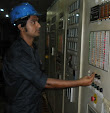Circuit Breaker
With the advancement of power
system, the lines and their equipment operate at very high voltages and carry
large current. The arrangement of switches along with fuses cannot serve the
desired function of switch gear in such high capacity circuits. This
necessitates employing a more dependable means of control such as is obtained
by the use of circuit breakers. A circuit breaker can make or breaker a circuit
either manually or automatically under all conditions ie no-load, full-load and
short circuit conditions. This characteristic of the circuit breaker has made it
very useful equipment for switching and protection of various parts of the
power system.
Operating Principle
A circuit breaker essentially consist of fixed and moving parts contacts, called electrodes. Under normal condition these contacts remain closed and will not open automatically until and unless the system becomes faulty. Of course the contacts can be opened manually or by remote control whenever desired. When a fault occur on any part of the system the trip coils of the circuit breaker get energized and the moving contacts are pulled apart by some mechanism, thus opening the circuit.
Fig: Circuit Breaker
Operating Principle
A circuit breaker essentially consist of fixed and moving parts contacts, called electrodes. Under normal condition these contacts remain closed and will not open automatically until and unless the system becomes faulty. Of course the contacts can be opened manually or by remote control whenever desired. When a fault occur on any part of the system the trip coils of the circuit breaker get energized and the moving contacts are pulled apart by some mechanism, thus opening the circuit.
When the contacts of a circuit
breaker are separated under fault conditions, an arc is struck between them. The
current is thus able to continue until the discharge ceases. The production or
arc not only delays the current interruption process but it also generates
enormous heat which may cause damage to the system or to the circuit breaker
itself. Therefore, the main problem in a circuit breaker is to extinguish the
arc within the shortest possible time so that heat generated by it may not
reach a dangerous value.
Classification
- Air Break Circuit Breaker
- Air Blast Circuit Breaker
- Sluphur Hexafluoride (SF6) Circuit Breaker
- Minimum oil and Bulk Oil Circuit Breaker
- Vacuum Oil Circuit Breaker










